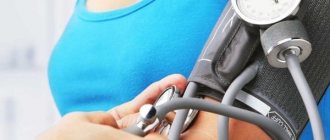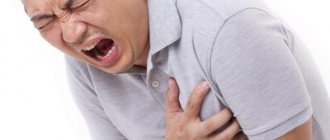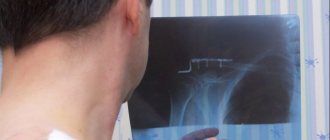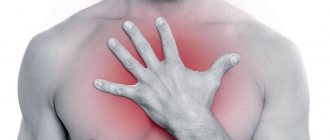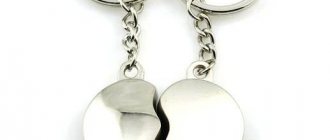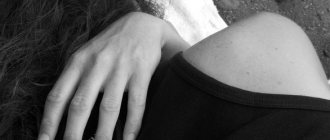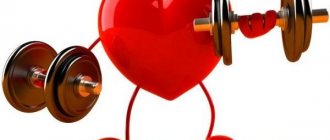What kind of pain could it be?
Everyone's stomach hurts differently. It depends on the specific cause of the symptom. And in order to identify the problem, you need to describe your pain and other details in as much detail as possible. So, what should you pay attention to?
- When does it hurt most often in the stomach area? Pain can occur immediately after eating or some time after eating. It also happens that the stomach hurts only when a person is hungry or when he is very nervous or has subjected his body to serious stress.
- How exactly does the belly in the stomach area make itself known? The nature of the sensations can be different: aching pain, cutting pain, strong and sharp, girdling pain and others. This is an important point.
- At what time does the stomach usually hurt in the stomach area: at night, in the morning or evening or during the day? This information can also help the doctor.
- What symptoms are accompanied by pain in the abdomen and stomach? Nausea, belching, and vomiting are likely to occur. In some cases, the body temperature may rise, and in other people the general condition deteriorates significantly.
- If your stomach hurts, remember what you ate.
Which doctor should I contact?
If the origin of the burning sensation is in doubt, you should consult a physician. After diagnosis, the patient will be referred to a specialist doctor, who will begin treatment. Often the patient suspects what caused the burning sensation in the lower back. It is advisable to immediately make an appointment with a gynecologist, endocrinologist, gastroenterologist, nephrologist, or urologist.
Causes of pain
What can cause stomach pain? Pain in the stomach area can occur for a variety of reasons. They can be divided into four groups:
- The first group includes problems or pathologies of the structure of the stomach itself. For example, the following problems may arise: gastritis, polyps, cancer, peptic ulcers, food poisoning and other conditions.
- The second group includes infections of the digestive system, one of the symptoms of which is severe cramping pain in the intestines and stomach.
- The third group includes problems with other systems and organs. So, the following causes are likely: pancreatitis, pathologies of the large or small intestine, appendicitis and others.
- And the fourth group is other factors, for example, stress, heavy physical activity or injuries and damage.
It is worth dwelling in detail on each cause of discomfort in the stomach.
Gastritis
Gastritis in medical practice refers to a number of pathological changes in the structure of the gastric mucosa, as a result of which digestion may be impaired.
This disease can be divided into several types:
- Acute gastritis occurs with a one-time aggressive impact on the membranes. In this case, the sensations are quite strong, cutting, and occur suddenly (at the moment of exposure).
- Chronic gastritis is caused by long-term and often sluggish changes in the structure and structure of the mucous membrane. Such a disease up to a certain point (until the integrity of the membrane is broken) can be completely asymptomatic.
- Chemical is caused by exposure to chemical substances on the mucous membrane.
- Autoimmune gastritis is a fairly rare occurrence. In this condition, the immune system recognizes the linings of the stomach as foreign and begins to attack and destroy them.
- Erosive gastritis is a consequence of constant or prolonged consumption of alcohol, spicy or very salty foods.
- Atrophic occurs due to thinning of the mucous membrane under the influence of some unfavorable factors.
- Bacterial gastritis develops due to the activity of bacteria, the main of which is Helicobacter pylori.
- Eosinophilic gastritis most often occurs due to exposure of the mucous membranes to parasites or allergens.
Along with unpleasant sensations in the stomach area, other symptoms may be observed: belching, heartburn, nausea, heaviness and distension (the stomach seems inflated and large), weakness and irritability, loss of appetite, unpleasant taste in the mouth, and others.
As for the treatment of such a disease, first of all, the cause of its occurrence should be identified and eliminated. The doctor may prescribe a drug to reduce the acidity of the juice and to restore the mucous membranes. Antibacterial therapy is sometimes indicated. And another important point is adherence to nutrition and diet.
Peptic ulcer
An ulcer is a violation of the integrity of the mucous membranes of the stomach. In other words, it is a kind of wound. And when gastric juice or food gets on it, pain occurs.
They are not always strong, it depends on the stage of the disease. So, with such a disease, the stomach most often begins to make itself felt when a person is hungry (gastric juice secreted in large quantities irritates the mucous membranes) or after taking spicy food or alcoholic drinks.
Unpleasant sensations may be accompanied by nausea or vomiting, weakness and loss of appetite.
The ulcer is extremely dangerous due to the likelihood of perforation. In this case, a hole is formed in some area of the stomach through which juice and food enter the abdominal cavity. Bleeding may occur and death is likely. In this situation, immediate medical attention is required.
The ulcer is being successfully treated. This takes time, it is important to follow all the doctor’s recommendations. So, a strict diet is prescribed with the exception of fatty, hard, smoked and salty foods, as well as alcohol. Drugs are prescribed that reduce the production of hydrochloric acid in the stomach. After some time, the shell is completely restored.
Polyps
A polyp is a growth in the stomach consisting of a collection of tissue cells. It can occur due to irritation of the mucous membrane or due to infection.
There may be no symptoms of this condition, but if the polyp is quite large, the person may notice that part of the abdomen in the stomach area hurts. Heaviness and discomfort may be felt, and nausea or vomiting is less common.
As a rule, polyps themselves are not dangerous, but in some cases they can increase the risk of developing malignant neoplasms, so it is better to eliminate this problem. This is done surgically.
Modern medicine involves a minimum of damage and scars. So, during endoscopy, the device is inserted through the mouth and passes through the esophagus into the stomach cavity. Abdominal surgeries are rarely prescribed. If the disease does not interfere with a person, then you just need to follow a diet and diet.
Cancer tumor
The stomach may hurt due to a cancerous tumor developing in the stomach. The reasons for its occurrence may be different. Risk factors include people with gastritis, ulcers or polyps.
As for symptoms, in the early stages they can manifest themselves in the form of occasional pain. They begin at any time and do not depend on food intake. Appetite may also decrease and general weakness may occur.
But there are also nonspecific manifestations: discomfort, a feeling of fullness, aversion to meat, anemia and sudden weight loss. In the later stages, the stomach hurts severely and bleeding may begin.
The tumor can be removed surgically or through chemical or radiation therapy. Treatment will be successful if started at an early stage of the disease.
Poisoning
If a person has eaten a low-quality product, the digestive organs will certainly react to this.
First of all, unpleasant sensations will arise, which are often quite strong. In addition, nausea and vomiting, as well as diarrhea, often begin. The condition will worsen, weakness and loss of appetite will occur.
Treatment involves removing toxins with the help of sorbent drugs (for example, Enterofuril), as well as eliminating symptoms.
Intestinal infections
Intestinal infections (for example, salmonellosis, rotavirus and others) enter the digestive system and cause a number of symptoms.
First of all, there will be severe cramping pain in the abdomen (in the stomach area). They may be accompanied by vomiting, diarrhea, increased body temperature to critical levels, as well as a general deterioration of the condition.
Treatment involves eliminating the infectious agent. If it is bacteria, then antibiotic drugs are indicated, and in the case of a viral disease, the use of antiviral agents is necessary. Nutrition should be gentle. If possible, it is better to adhere to bed rest.
Intestinal problems
In the lower part of the described area are the upper intestines. And problems with their functioning may be accompanied by abdominal pain. So, the cause of troubles can be diseases such as pancreatitis, colitis and others.
As for symptoms, they may be as follows:
- discomfort and unpleasant sensations in the abdominal cavity;
- bloating;
- nausea and vomiting;
- diarrhea;
- constipation.
If we talk about treatment, only a doctor can prescribe it. In some cases, the use of painkillers and agents that improve digestion processes and speed up the processing of food in the intestines is indicated. You should also follow your diet and nutrition regimen.
Cardiovascular diseases
If your stomach hurts, this may be due to problems in the functioning of blood vessels or the heart. So, the most important and large artery passes through this part. And, for example, its rupture will certainly be accompanied by pain.
In addition, heart pain can also be localized in this part and radiate to others (to the sides or shoulder blades). So it’s worth examining the cardiovascular system to avoid sad consequences.
Appendicitis
The stomach may hurt if the appendix is inflamed. Yes, it is located in the lower side, but along the nerve endings the pain can reach the upper area (it often radiates to the other side).
With appendicitis, the body temperature rises and vomiting may begin. This condition requires immediate surgery, because the appendix can burst and the contents spill into the abdominal cavity, which is extremely dangerous.
Diaphragm
The diaphragm is a muscular organ that is located in the area of separation of the abdominal and thoracic cavities. For some reasons (staying in an uncomfortable position for a long time, injury), this muscle can sharply contract. And such a reduction can be quite painful.
In this situation, the stomach will hurt in its uppermost part. The sensations can be quite sharp and shooting. But after changing position they usually go away. Although with a diaphragmatic hernia, symptoms persist for a long time.
Localization of abdominal pain
Diagnosis of pain in the epigastric region is one of the most difficult and important tasks in medicine. Due to the urgency of the situation, a routine systematic examination of the patient is often impossible. The doctor’s clinical experience is of great importance here, since sometimes in acute, life-threatening conditions, the picture of the disease is blurred. With the most vivid picture of an “acute abdomen,” surgical treatment may not be necessary, and, on the contrary, mild pain may be the first sign of a disease for which emergency surgery is indicated. Be that as it may, any acute, unusual abdominal pain requires a comprehensive examination.
In classic cases, there is a correspondence between the localization of pain and the affected organ.
The pain is localized below the waist (lower abdomen): • A man may have diseases of the urinary system; monitor urination and urine output; • A woman may have diseases of the urinary system, pregnancy, painful menstruation, inflammation of the internal genital organs.
Pain above the pubis (lower abdomen, “lower abdomen hurts”) in women - pathological processes in the bladder, uterus and appendages, may indicate problems with the reproductive system. Pelvic pain that occurs every month before menstruation may indicate endometriosis, a condition in which particles of tissue from the uterus move through the fallopian tubes and land on the ovaries, pelvis, bladder and other organs. Tenderness in the lower abdomen may indicate pelvic inflammatory disease (infection of the uterine tissue, fallopian tubes, or ovaries). In women of childbearing age, ectopic pregnancy can also cause sharp, sharp or stabbing pain in the peritoneum, accompanied by vaginal bleeding, irregular menstrual cycles and pain radiating to the shoulders. Ovarian cysts and uterine fibroids can also cause abdominal pain in women. Read more about lower abdominal pain in women.
Pain is localized in the projection of the stomach in diseases of the esophagus, stomach, and duodenum. However, with myocardial infarction, pneumonia and pyelonephritis, there may be a similar localization: if the stomach hurts, doctors think not only about digestive problems.
Pain in the umbilical region - with diseases of the small intestine.
Pain in the right iliac region (near the wing of the ilium on the right) - the cecum and appendix. In the left iliac region - the sigmoid colon.
Abdominal pain began in the lower back and moved to the groin : possible pathology of the urinary system, urolithiasis.
Abdominal pain spreads in the area of the right hypochondrium (in the abdomen on the right, may extend under the right shoulder blade): pathology of the liver, biliary tract or gall bladder is possible; Observe skin color, urine and stool color.
Acute pain in the right hypochondrium, worsening after eating , indicates the presence of gallbladder damage. Gallbladder diseases include stones and inflammation of the gallbladder (cholecystitis). If complications occur, gallbladder damage may also have other symptoms, these include: jaundice (yellowing of the skin and whites of the eyes), severe fever and chills. Sometimes people with gallstones experience no symptoms at all. If you experience regular pain in the right hypochondrium, you should consult a doctor. Gallbladder pain can be managed in a number of ways, ranging from simply waiting it out (observing symptoms for some time and not getting any treatment) to taking medications and even surgery. You can also reduce the symptoms of gallbladder disease by reducing the amount of fat in your diet.
Pain is most often localized in the left hypochondrium (in the left abdomen) with pancreatitis. Pain from ulcers and pancreatitis usually radiates through the entire back.
In the center of the upper abdomen: • This may be heart pain (spreading up the chest and even into the arms); • It is possible that digestive disorders may occur as a result of overeating, emotional or physical stress.
Above the waist: • Possible digestive disorders in the stomach (gastritis) or duodenum.
Below the navel: • If there is swelling and a feeling of discomfort in the groin, which increases with physical activity or coughing, a hernia cannot be ruled out (can only be treated by a doctor); • Possible constipation or diarrhea; • In women, if there is dysfunction of the genital organs (monitor vaginal discharge) or pregnancy.
Pelvic pain usually feels like pressure and discomfort in the rectal area.
Abdominal pain relieved by bowel movements and accompanied by diarrhea or constipation may indicate irritable bowel syndrome, a common gastrointestinal disorder for which the cause has not yet been identified. When irritable bowel syndrome occurs, the intestinal walls contract too much, sometimes too little, sometimes too slowly, and sometimes, on the contrary, too quickly. Symptoms of this disease include: bloating, increased gas production, slimy stools, and a constant desire to empty the intestines. This syndrome cannot be treated with surgery or medications. However, worsening of the condition can be prevented by drinking plenty of water, increasing the amount of fiber in your diet, reducing the amount of caffeine you consume and increasing exercise.
Pain in the left lower abdomen can be a symptom of diverticulitis. Diverticulitis occurs when small, ball-shaped capsules called diverticula form in the walls of the colon, which subsequently become infected and inflamed. Other symptoms of diverticulitis include fever, nausea, vomiting, chills, cramps and constipation. Treatment for diverticulitis usually involves clearing the colon of infection and inflammation. Your doctor may prescribe antibiotics and/or pain medications, a liquid diet, and bed rest for several days. In some cases, treatment for diverticulitis requires a hospital stay. If complications occur, surgery may be necessary. The best way to prevent diverticulitis is a diet rich in fiber. Dietary fiber promotes proper digestion and relieves pressure in the colon. Gradually increase the amount of fiber in your daily diet and drink plenty of fluids. Emptying your bowels on time will also help prevent diverticulitis. The accumulation of waste from the digestive system causes an increase in pressure in the colon.
Sharp, burning pain in the upper and middle abdomen (between the breastbone and belly button) may indicate the presence of an ulcer. An ulcer is a wound that forms in the tissue of the stomach or upper intestine. There are many causes of ulcers. Smoking, taking acetylsalicylic acid, ibuprofen or other non-steroidal anti-inflammatory drugs may play a role. An ulcer can also form if the stomach is unable to protect itself from strong stomach acids. Helicobacter pylori, a bacterium that lives in the stomach, can also cause ulcers. Stress and spicy foods cannot cause ulcers. Heartburn alone cannot indicate this disease. Severe pain like heartburn can also be caused by a less serious condition called gastroesophageal reflux disease.
Colic is cramping pain in the abdomen, during which periods of increasing pain alternate with “light intervals.” The development of colic is often provoked by a violation of the diet or a bumpy ride. At the height of pain, patients often rush around or take a forced position to reduce discomfort. Biliary colic occurs with cholelithiasis, biliary dyskinesia. Foreign bodies in the ducts: breakthrough of parasitic cysts, liver abscesses, helminthic infestations manifest themselves as biliary colic. Intestinal colic is a manifestation of acute inflammatory processes in the intestines, intestinal obstruction, irritable bowel syndrome and other diseases. The main therapeutic measures are antispasmodics. However, this prescription cannot be limited, since emergency and delayed interventions of a different nature are sometimes required to eliminate the underlying cause. If any acute and unusual abdominal pain occurs, a medical examination is necessary.
The stomach hurts constantly, the pain is acute or growing - you need to consult a gastroenterologist who will decide on the examination tactics.
Attention! Signs such as persistent abdominal pain that does not subside within 2 hours, abdominal pain when touched, the addition of vomiting, diarrhea, and elevated body temperature should seriously alert you .
If abdominal pain is accompanied by dizziness, weakness, decreased blood pressure, increased heart rate, visible bleeding, fever, repeated vomiting, increased intensity, fainting, tension in the muscles of the abdominal wall, then urgent diagnostic measures, intensive monitoring, and a decision on the advisability of surgical intervention are necessary.
Hell in the stomach
If a person feels a burning sensation in the stomach, then such a symptom may not always be a consequence of poor nutrition. Most often, heartburn is provoked by increased acidity, which occurs both before and during meals, when gastric juice burns the surface of the mucous membrane. Less common in medical practice is increased susceptibility of the lining of the esophagus. Often the stomach burns and other manifestations appear at the same time. Possible disturbances in the digestive system are indicated by a sour taste in the mouth and throat. Then a specific odor appears from the mouth, which indicates the consumption of junk food and an unhealthy diet.
First aid for abdominal pain
By eliminating the pain and reducing the temperature (and many painkillers effectively reduce the temperature), you will make it difficult for doctors to make a diagnosis, and this can lead to serious complications. Remember that abdominal pain in almost all cases is a rather serious phenomenon that cannot be treated indifferently, because the most important human organs are located in the stomach. Problems of the heart, digestive and endocrine systems, and reproductive systems can manifest as abdominal pain. Therefore they should not be taken lightly
First aid to a patient
Constant burning in the lower back causes not only physical, but also psychological discomfort. It is possible to get rid of it only by eliminating the pathology that provoked it. But even during treatment, a burning sensation occurs from time to time. Cold compresses will help reduce the severity of discomfort. Apply a thick cloth soaked in cool water to your lower back for 15-20 minutes.
Diagnostics
To establish the cause of a burning sensation in the left lower abdomen or any other location, particularly in pregnant women, an integrated approach is required.
If the main symptom occurs, you should seek help from a gastroenterologist, because most often it is a consequence of gastrointestinal diseases. First of all, the doctor must:
- study the patient's medical history;
- collect the patient’s life history – this includes information regarding the medications used and the person’s diet;
- conduct a thorough physical examination aimed at palpating the anterior wall of the abdominal cavity, measuring temperature, blood pressure and pulse, as well as identifying other external symptoms;
- interview the patient in detail to determine the severity of the burning sensation below the navel or in another area of the abdomen, and the presence of additional symptoms.
Laboratory and instrumental diagnostics include:
- general clinical blood test;
- blood biochemistry;
- general urine analysis;
- microscopic examination of feces;
- breath test - to detect the presence of the bacterium Helicobacter pylori in the body;
- Ultrasound of the abdominal cavity and FEGDS;
- CT and MRI;
- radiography and gastroscopy.
Breath test for Helicobacter pylori
If the cause of a burning sensation in the abdomen, including during pregnancy, is associated with pathologies of other internal organs and systems, then after the initial examination the patient may be referred for additional examination to:
- cardiologist and pulmonologist;
- neurologist and dermatologist;
- pediatrician and obstetrician-gynecologist.
Treatment
If isolated manifestations of discomfort in the stomach can be relieved by periodic medication, then in the presence of diseases of the digestive tract, comprehensive treatment must be prescribed. Only a combination of several therapeutic methods will help avoid the progression of pathology and eliminate discomfort.
Stomach pain after eating
Complex treatment necessarily includes taking medications prescribed by a doctor and a special diet. In addition, after consultation with a specialist, you can alleviate the patient’s condition using traditional methods. For the normal functioning of the gastrointestinal tract, it is important to give up bad habits, avoid stress and infectious diseases.
But it is not always possible to immediately visit a doctor so that he can prescribe treatment. Therefore, every person needs to know what to do to get rid of the burning sensation. Most often it is recommended to dissolve a teaspoon of soda in a glass of warm water and drink. Mineral water, from which you first need to release gases, and activated carbon also helps. These methods will help neutralize hydrochloric acid, but if the causes of the pathology are not eliminated, the burning sensation will appear again after a while.
If the burning sensation occurs frequently, you must avoid eating many foods that can cause such discomfort.
Nutrition
The most important thing to do if a burning sensation occurs frequently is to reconsider your diet. It is necessary to avoid drinking carbonated drinks, coffee, alcohol, fried and fatty foods, spicy, smoked and pickled foods. A burning sensation can be caused by eating yeast dough, baked goods, chips, canned food, and chocolate. It is unacceptable to overeat, but prolonged fasting is also harmful to the stomach.
You need to eat porridge, vegetable soups, stewed vegetables, salads. You can eat lean meat or fish, dairy products. Almonds help relieve burning sensation. You need to pour boiling water over them and remove the skin, and then eat them, chewing them well. When there is a burning sensation in the stomach, it is also recommended to drink still mineral water, a decoction of oat grains or flaxseeds. It is useful to eat buckwheat porridge more often. You can grind this cereal in a coffee grinder and take half a teaspoon of flour three times a day.
Drug therapy
There are several groups of medications to relieve a burning sensation in the stomach. Most often, several drugs are prescribed in combination. After all, they relieve certain symptoms of pathology: nausea, flatulence, slow digestion, pain and burning in the stomach. They need to be taken in courses; they relieve the patient’s condition well. But without following a special diet, even the most powerful drugs will be ineffective. Therefore, if your stomach often hurts and heartburn appears several times a week, it is advisable to reconsider your eating habits.
There are many remedies for heartburn and burning on the market now, but they only have a temporary effect.
There are no special remedies that relieve this symptom. Drugs are used that protect the gastric mucosa, reduce the acidity of gastric juice, improve digestion by promoting less release of hydrochloric acid, and also quickly empty the stomach of food.
- The most common remedies for pain and burning in the stomach are antacids. They envelop the mucous membrane, protecting it from an aggressive environment, reduce acidity, and reduce pain. These are Almagel, Gaviscon, Phosphalugel, Rennie, Maalox.
- Gastroprotectors are also effective, they protect the walls of the stomach, increase the resistance of the mucous membrane to acids, and accelerate regenerative processes. These are De Nol, Escape, Novobismol, Bismuth nitrate, Ulgastran, Omeprazole.
- To prevent fermentation and rotting of food in the stomach and to digest it more quickly, it is recommended to take enzyme preparations. The most common are Mezim, Festal, Creon.
- There are also medications that improve gastrointestinal motility, eliminating discomfort and accompanying symptoms of burning - nausea, flatulence, belching, bloating. These are Motilium, Ganaton, Domperidone, Cerucal.
Burns in the stomach area
When the “stomach is on fire”, in contrast to heartburn, it does not burn in the upper parts of the larynx (as a result of reflux disease and involuntary reflux of food into the esophagus), but discomfort is felt somewhat lower - in the epigastric region. Despite the different etiologies, their treatment is similar.
The burning sensation is accompanied by irritation and injury to the mucous membranes due to increased acidity of gastric juice, peptic enzyme activity and the formation of ulcers. It can “burn with fire” when a person is very hungry and acidic gastric juice reaches erosive areas.
Irritation of the mucous membranes can occur not only due to acidic gastric contents, but in more rare cases it is caused by alkaline reflux. In this case, the mucous membranes are exposed to the action of bile acids, which enter the stomach through the duodenogastric reverse flow of bile.
The pathological process begins with an imbalance in the ratio of “aggressive” and “protective” factors of the digestive system. The main aggressive effect is to increase the activity of proteolytic enzymes and the level of acidity secreted by gastric juice, along with a deterioration in the motility of the digestive organs. Protective properties are reduced if:
- less mucus is produced;
- the processes of natural physiological regeneration of the epithelial surface slow down;
- local blood circulation, innervation and trophism are disrupted.
For example, this can occur under conditions of prolonged or repeated psycho-emotional stress against a background of negative emotions.
A separate predisposing factor, along with heredity and family history, are deficiencies in diet and nutrition, smoking and alcohol abuse.
The pathological process is based on proteolytic destruction of tissue by gastric juice in an area with deteriorated trophism, which is most often observed in the lower parts of the stomach. A decrease in the alkaline component and prolonged contact with acidic gastric juice is possible with spasm of the gastric sphincter - the pylorus. In addition, the level of mucin contained in mucus, the state of the apical membranes of enterocytes, and nervous and vascular trophism are important.
When the mucous barrier and the protein-lipid complex of the apical membranes are destroyed, reverse diffusion of hydrogen ions into the cell membranes occurs, which activates the kinin-kallikrein inflammatory system and increases the permeability of the capillary network. This leads to microcirculation disorder, then lipid peroxidation products are formed as a result of oxidative degradation of lipids under the influence of free radicals, damaging lysosomes.
The negative neuro-emotional effect on the gastrointestinal tract occurs through the anterior parts of the hypothalamus, along the path of the vagus nerve, acetylcholine, histamine and gastrin receptors in glandular tissues.
Burns in the stomach what to do
Therapy for the condition involves an integrated approach. The patient is selected an individual regimen not only for taking medications, but also the medications themselves. During the period of exacerbation of the identified disease, intensive drug treatment is prescribed. Later, during the period of remission, the person is prescribed maintenance therapy.
How to treat such a symptom as a burning sensation in the stomach? The list of drugs used is huge. The following groups of drugs are most often prescribed:
- alginates and antacids - antiulcer drugs, used to neutralize the increased acidity of hydrochloric acid;
- gastroprotectors – help protect the gastric mucosa;
- analgesic – help relieve pain;
- prokinetics – activate gastrointestinal motility;
- antispasmodics – eliminate spasms;
- Digestive enzymes – improve food digestion processes;
- laxatives – recommended for constipation;
- antibiotics – used in the presence of infection;
- probiotics – necessary to restore the balance of intestinal microflora;
- rehydrants – help restore water and electrolyte balance caused by diarrhea and/or vomiting;
- enterosorbents – accelerate the removal of toxins from the lumen of the intestinal tract;
- carminatives - used to reduce gas formation;
- antiemetics;
- anthelmintic.
The use of only medications that eliminate pain and burning sensation will not completely cure the pathology. They only help relieve severe symptoms. But the main therapy is adherence to the principles of dietary nutrition.
